Whether cloud, hybrid, or on-premises IT infrastructures: in the end, all applications, services, and virtual machines run on physical servers located in a building – the data center. This physical backbone makes it crucial to have a central overview of not only the IT network but also the data center facilities themselves.
To ensure the trouble-free operation of a data center, it is essential to keep a constant eye on a whole range of different components, both in classic IT and in building services engineering. This way, you can detect faults or unusual activity as early as possible and so avoid breakdowns, damage, and even unauthorized intrusion.
Data centers are cost- and resource-intensive. They need hardware for a reliable IT infrastructure, comprehensive building security measures, climate regulation systems and intelligent power management with backup and redundancy systems in the event of an emergency.
To save on operating expenses for hardware, maintenance, and energy consumption, you need a monitoring solution that collects and stores real-time monitoring data. This provides a precise basis for long-term data analysis and appropriate optimization measures.
Classic IT network attacks are only one aspect how the security of a data center can be compromised. Physical security issues like overheating or even cable fire, leaks in air conditioning systems, as well as unauthorized intrusion can cause massive damage.
This is why a monitoring tool is key to keeping an eye on humidity, temperature, smoke, and other environmental influences, and making sure that CCTV systems and entry alarms as well as firewalls and virus scanners are working properly.
In many cases, there’s not only the one enterprise data center that a company owns. Often, several data centers are used to fulfill different functions and many data center providers also operate various smaller edge data centers that are located more closely to the end user.
All these remote sites produce massive amounts of monitoring data. A professional data center monitor must be able to bring all collected data – even if it’s only from different rented spaces in a colocation data center – together in a unified monitoring overview with a central alerting system.
Diagnose issues with your data center IT infrastructure by continuously monitoring your hardware, applications, environmental metrics, building security, and more. Show monitoring data in real time and visualize it in graphic maps & dashboards to identify problems more easily. Gain the visibility you need to troubleshoot issues and guarantee service continuity.
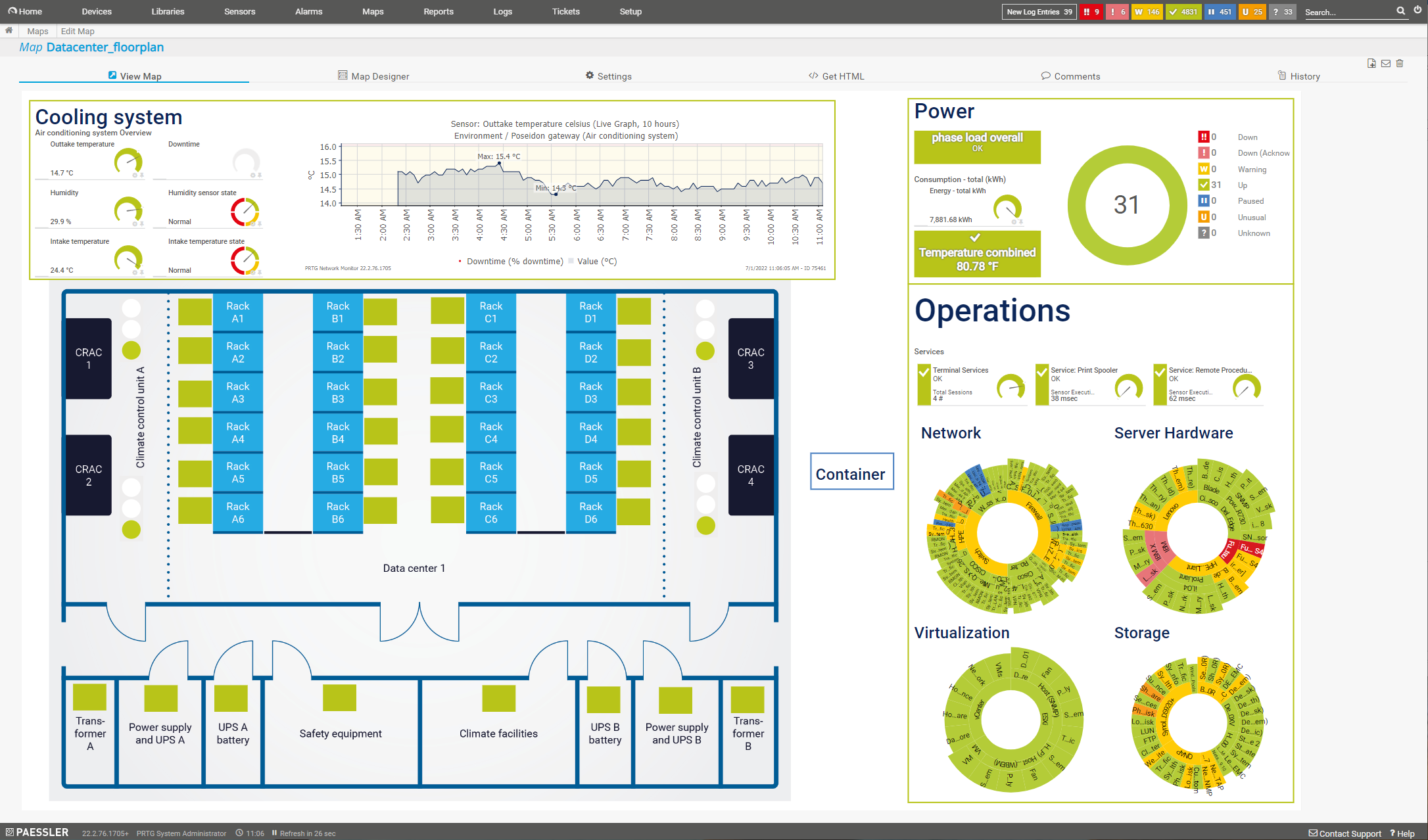
Custom PRTG dashboard for data center monitoring
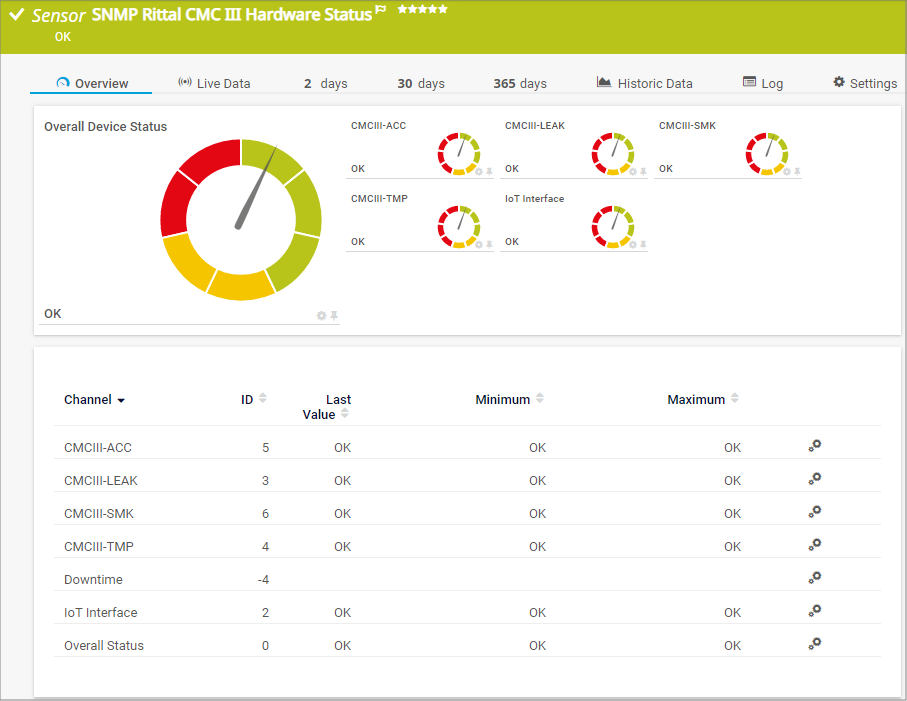
Preconfigured SNMP Rittal CMC III Hardware Status sensor
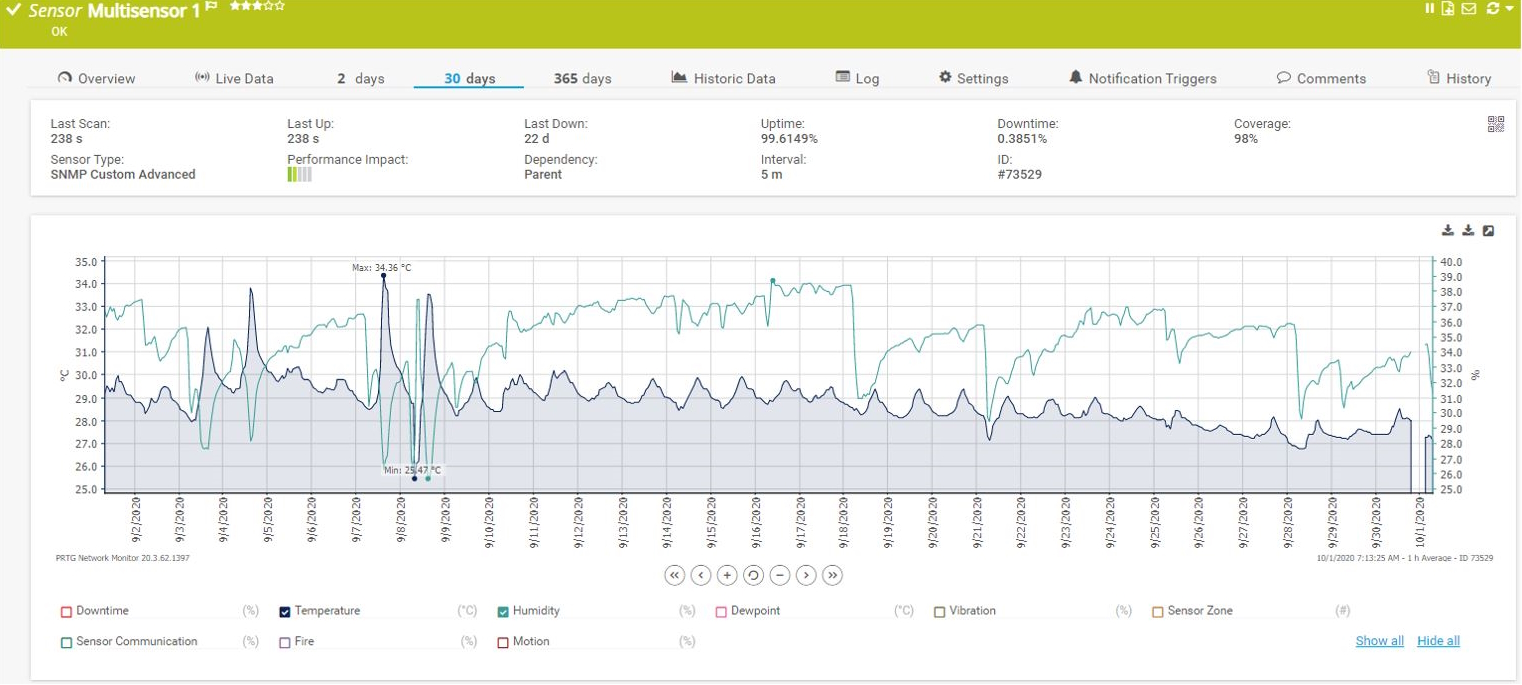
Preconfigure30-days graph for temperature and humidity datad MQTT Round Trip sensor in PRTG
“Excellent tool for detailed monitoring. Alarms and notifications work greatly. Equipment addition is straight forward and server initial setup is very easy. ...feel safe to purchase it if you intend to monitor a large networking landscape.”
See the PRTG Manual for a list of all available sensor types.
Companies around the world trust PRTG Network Monitor when it comes to ensuring that their IT systems run smoothly.
As one of the leading data center operators in the Netherlands, All IT Rooms plans, builds, and operates data centers for customers of all industries. Since 2017, All IT Rooms have relied on PRTG as the basis for its self-developed DCIM solution All-BaaS®. PRTG monitors all components of the data center infrastructure, from cooling systems to uninterruptible power supplies, generators, security systems, and more.
windCORES are data centers inside wind turbines, the first of their kind in the world. The windCORES brand belongs to the WestfalenWIND Group, which was founded in 2009. Decentralized data centers require a centralized monitoring solution. PRTG monitors the infrastructure of each windCORES data center, as well as the cloud services that customers rent from the data centers in the individual turbines.
ASAC Comunicaciones S.L. is an IT consulting company and MSP in Asturias, Spain. They offer a broad portfolio of products and services to their customers who are mostly from the public sector. ASAC assembled their first data center in 2008 and they chose PRTG to monitor the data center infrastructure, including physical servers, operating systems, cloud applications, and more.
Partnering with innovative IT vendors, Paessler unleashes synergies to create
new and additional benefits for joined customers.
Axis offers one of the most complete and reliable product portfolios, an expanded professional network, and comprehensive integration support for video management software.
Combining their tools to a powerful solution for advanced analysis and automation, KnowledgeRiver and Paessler enable IT teams to ensure best performance for their infrastructure and networks.
IT that works constitutes a business-critical basis for a company's success. Availability and security must be defined for the respective purpose and closely monitored – by OT and IT alike.
This white paper introduces Paessler PRTG as a comprehensive solution for data center monitoring including the monitoring of energy and power supplies, as well as environmental parameters such as temperature or humidity.
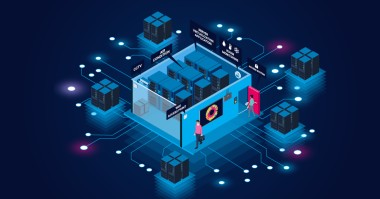
Find out what aspects of a data center you need to keep an eye on in order to ensure its excellent performance and trouble-free operation. This includes IT network and infrastructure, building facilities, and security.
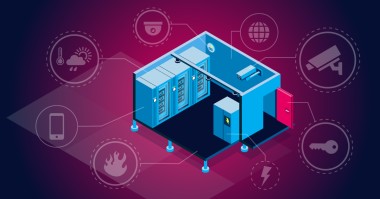
Have a more detailed look at how you can increase the physical security of your data center, particularly the server room. Security aspects to keep in mind are access control, CCTV surveillance, and environmental monitoring.
Data center monitoring is the systematic observation and analysis of various aspects within a data center environment. It involves using specialized tools and software to collect and analyze data from various sensors, devices, and systems within the data center. The goal is to proactively identify issues, optimize resources, maintain uptime, enhance security, and support decision-making for better operational efficiency.
Monitoring data centers involves the continuous tracking and analysis of multiple parameters such as hardware performance and health, environmental conditions, power usage, network traffic, security measures, and application performance.
Power usage monitoring in a data center involves the continuous measurement, analysis, and management of electrical consumption throughout the facility. Here's a breakdown of how it typically works.
Data centers use power metering devices installed at various points within the electrical infrastructure. These devices measure electrical parameters such as voltage, current, power factor, and energy consumption.
Sensors and meters are strategically placed across the data center, including at power distribution units (PDUs), uninterruptible power supplies (UPS), servers, cooling systems, and other critical equipment. These sensors continuously collect data on power usage.
The data collected from these meters and sensors are aggregated and consolidated by specialized monitoring systems or software like Paessler PRTG. These systems gather real-time information about power consumption from multiple sources within the data center.
Monitoring software processes the collected data to generate insights and reports. It provides information on energy consumption trends, peak usage periods, power distribution inefficiencies, and potential areas for optimization.
The data is often visualized through dashboards or reports, allowing data center managers to easily interpret and analyze power usage metrics. These visuals provide insights into where power is being consumed most, enabling informed decision-making.
Monitoring environmental aspects in a data center isn't just about keeping the temperature and humidity at acceptable levels. It is crucial for several reasons:
Monitoring data center security involves various measures to safeguard the infrastructure and sensitive information stored within it. By implementing these measures, you create a layered approach to data center security, fortify against various threats, and ensure the protection of critical infrastructure and data. Find some of these measures below:
In PRTG, “sensors” are the basic monitoring elements. One sensor usually monitors one measured value in your network, for example the traffic of a switch port, the CPU load of a server, or the free space on a disk drive. On average, you need about 5-10 sensors per device or one sensor per switch port.